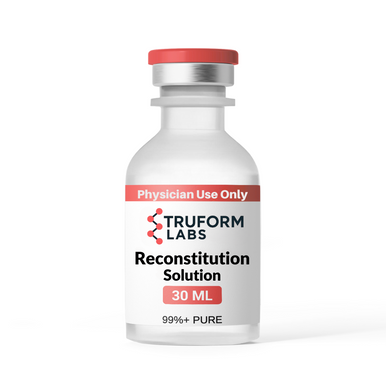Product Overview
Thymosin Beta 4
Thymosin Beta 4 (TB500) is a highly conserved, multifunctional peptide with broad regenerative and reparative properties. It is the most abundant β-thymosin in human cells, acting as a major G-actin–sequestering molecule and modulator of cytoskeletal dynamics.[1][2] TB4 is released by platelets and other cell types at sites of injury, where it helps initiate and orchestrate the repair cascade.[3]
Regenerative Properties & Wound Healing
- Accelerates dermal and epithelial wound healing in preclinical models and clinical settings (e.g., chronic ulcers, severe dermal injuries).[4][5][3]
- Promotes keratinocyte/epithelial migration, mobilizes and supports stem/progenitor cells, and increases angiogenesis—key processes for rapid tissue repair.[4][5][2][6][7][3][8]
- Inhibits apoptosis and dampens inflammation at wound sites, improving healing outcomes and tissue quality.[4][5][6][3]
Inflammation Reduction & Tissue Repair
- Downregulates inflammatory chemokines/cytokines (including NF-κB pathways) and blocks steroid-induced thymocyte apoptosis, reducing local/systemic inflammation.[9][6][3]
- The Ac-SDKP domain contributes anti-inflammatory and anti-fibrotic activity; utility noted in conditions with excessive inflammation or impaired repair (e.g., UC, liver/renal fibrosis, corneal injury).[6][10][1][11][3]
Cell Migration & Angiogenesis
- Actin-binding motif (LKKTETQ) drives endothelial migration, adhesion, tubule formation, and angiogenesis.[7]
- Stimulates vaso/angiogenesis and arteriogenesis in development and adult repair, enhancing perfusion and survival of injured tissues; upregulates matrix and remodeling programs.[9][12][7][3][2][6]
Injury Recovery & Scar Modulation
- Improves recovery after myocardial infarction, I/R injury, stroke, and trauma by activating epicardial progenitors, supporting cardiomyocyte survival, and moderating inflammatory injury.[11][9][12][3]
- Reduces myofibroblast burden and fibrosis → less scar formation; supports restoration of normal tissue architecture in dermal/corneal models.[3][4][5][8]
Cardiovascular Support
- Essential for myocardial vascularization; improves perfusion and function in acute/chronic ischemic heart disease via survival kinases, endothelial/myocyte protection, and epicardial progenitor differentiation.[9][12][3]
Summary: TB4 (TB500) is a cytoskeleton-modulating repair peptide that accelerates wound closure, reduces inflammation and fibrosis, promotes angiogenesis and progenitor activity, and supports recovery after ischemic and traumatic injury across multiple tissues.[1–12]
References
- Ying Y, Lin C, Tao N, et al. Curr Protein Pept Sci. 2023;24(1):78–88.
- Crockford D, Turjman N, Allan C, Angel J. Ann N Y Acad Sci. 2010;1194:179–89.
- Goldstein AL, Hannappel E, Sosne G, Kleinman HK. Expert Opin Biol Ther. 2012;12(1):37–51.
- Treadwell T, Kleinman HK, Crockford D, et al. Ann N Y Acad Sci. 2012;1270:37–44.
- Yang WS, Kang S, Sung J, Kleinman HK. Eur J Dermatol. 2019;29(5):459–467.
- Sosne G, Qiu P, Goldstein AL, Wheater M. FASEB J. 2010;24(7):2144–51.
- Philp D, Huff T, Gho YS, Hannappel E, Kleinman HK. FASEB J. 2003;17(14):2103–5.
- Philp D, Kleinman HK. Ann N Y Acad Sci. 2010;1194:81–6.
- Hinkel R, Trenkwalder T, Kupatt C. Ann N Y Acad Sci. 2012;1269:102–9.
- Xing Y, Ye Y, Zuo H, Li Y. Front Endocrinol. 2021;12:767785.
- Goldstein AL, Kleinman HK. Expert Opin Biol Ther. 2015;15(Suppl 1):S139–45.
- Bjørklund G, Dadar M, Aaseth J, Chirumbolo S. Curr Med Chem. 2020;27(37):6294–6305.
All COA’s avail upon request by email info@truformlabs.com.
Storage & Handling (Research Use)
- Lyophilized (dry) peptide: Store sealed at −20 °C (long-term). Short-term storage up to 2–3 weeks at 2–8 °C is acceptable.
- After reconstitution: Store at 2–8 °C and use within 7 days, or aliquot to sterile vials and freeze at −20 °C for up to 3 months.
- Light & moisture: Protect from light; keep container tightly closed to prevent moisture uptake.
- Freeze–thaw: Avoid repeated freeze–thaw (prepare small aliquots).
- Solvent compatibility: Use a sterile solvent compatible with your protocol; filter-sterilize if required.
- Labeling: Clearly label aliquots with concentration, solvent, and preparation date.
Storage guidance is general for research peptides and may be adjusted per your lab SOP.







